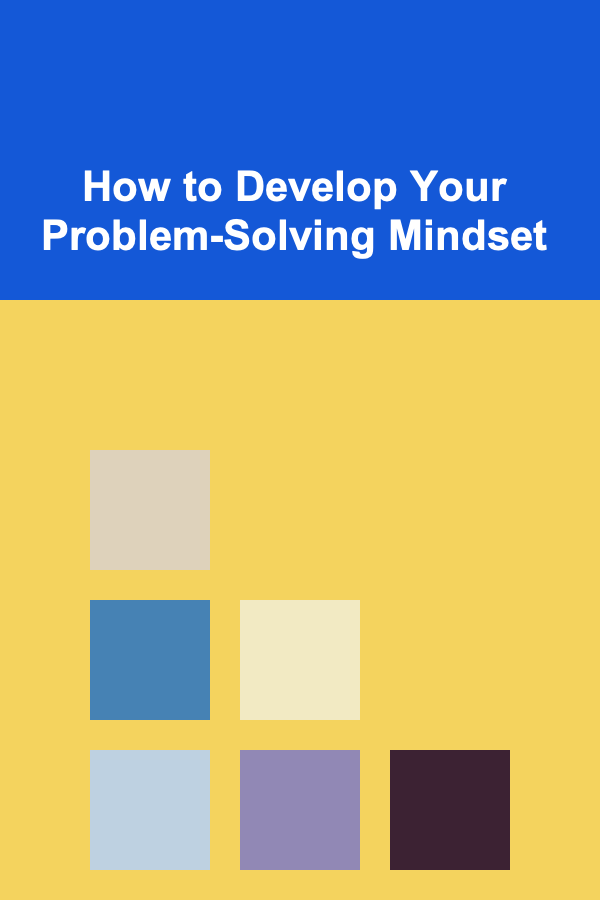
How to Develop Your Problem-Solving Mindset
ebook include PDF & Audio bundle (Micro Guide)
$12.99$11.99
Limited Time Offer! Order within the next:

Developing a problem-solving mindset is one of the most important skills in both personal and professional life. Whether you're faced with challenges at work, in your personal relationships, or in learning, cultivating the ability to approach problems with a solution-oriented perspective can make a world of difference. This article explores the key principles, techniques, and mindset shifts necessary for developing effective problem-solving abilities.
What is a Problem-Solving Mindset?
A problem-solving mindset refers to the mental framework and attitude that an individual adopts when faced with a challenge. It is a mindset that focuses on seeking solutions rather than dwelling on the problems themselves. A person with a problem-solving mindset is proactive, adaptable, and resourceful. Rather than seeing obstacles as insurmountable, they view challenges as opportunities to grow, learn, and innovate.
The problem-solving mindset is not about magically having all the answers; rather, it is about having the tools and mental agility to navigate uncertainty and complexity. It involves creativity, persistence, critical thinking, and the ability to make informed decisions under pressure.
Why is a Problem-Solving Mindset Important?
- Boosts Confidence: When you approach challenges with a problem-solving mindset, you're more likely to feel confident in your ability to handle obstacles. This self-assurance encourages perseverance and reduces fear of failure.
- Encourages Innovation: A problem-solving mindset encourages you to think outside the box. It pushes you to seek new and innovative ways to approach tasks or find solutions.
- Increases Resilience: Life is full of setbacks, and a problem-solving mindset helps you bounce back from failures more easily. Instead of giving up, you keep trying different approaches until you find a solution.
- Improves Decision-Making: People with a problem-solving mindset excel at making informed decisions because they systematically evaluate options and weigh risks, benefits, and consequences.
- Enhances Collaboration: Effective problem-solvers are also great collaborators. They know how to leverage different perspectives, skills, and expertise to solve complex issues.
Steps to Develop Your Problem-Solving Mindset
1. Shift from a Fixed to a Growth Mindset
A growth mindset, a term coined by psychologist Carol Dweck, is the belief that abilities and intelligence can be developed over time. When you shift from a fixed mindset, where you believe your abilities are set in stone, to a growth mindset, you become more open to learning from failures and seeking improvement.
People with a fixed mindset often avoid challenges because they fear failure, whereas those with a growth mindset view failure as an opportunity to learn. This shift is vital for developing problem-solving skills because it encourages continuous learning and adaptability.
How to cultivate a growth mindset:
- Embrace challenges instead of avoiding them.
- Learn from criticism and feedback.
- Understand that effort leads to improvement.
- Celebrate progress rather than focusing solely on the outcome.
2. Develop Emotional Intelligence
Emotional intelligence (EQ) is crucial for problem-solving, especially when emotions run high. People with high EQ are able to manage their emotions effectively, stay calm under pressure, and make rational decisions even when they are faced with stressful situations. By being aware of your emotions and how they influence your thinking, you can maintain clarity and focus when solving problems.
Key components of emotional intelligence:
- Self-awareness: Recognizing your emotions and how they affect your thoughts and behaviors.
- Self-regulation: Managing your emotions in healthy ways, especially in stressful situations.
- Empathy: Understanding and considering other people's emotions and perspectives.
- Social skills: Building healthy relationships, resolving conflicts, and collaborating with others.
3. Practice Critical Thinking
Critical thinking is the ability to analyze and evaluate information objectively and systematically. It involves questioning assumptions, identifying biases, and considering alternative perspectives. This skill is vital for problem-solving because it helps you approach issues from a variety of angles and avoid tunnel vision.
A critical thinker does not accept things at face value but seeks to understand the underlying causes and implications of problems. They ask questions such as: Why is this happening? What are the potential consequences of each solution? What evidence supports this claim?
How to practice critical thinking:
- Question assumptions and beliefs that you hold.
- Gather and evaluate evidence before drawing conclusions.
- Consider multiple perspectives on an issue.
- Break down complex problems into smaller, manageable parts.
- Make decisions based on logic and evidence rather than emotions.
4. Break Down Problems into Smaller Parts
Large problems can often feel overwhelming, and this can lead to frustration or paralysis. Breaking down complex problems into smaller, manageable pieces makes them less intimidating and helps you focus on solving one step at a time.
By deconstructing problems, you identify key components and better understand the underlying causes. This allows you to prioritize tasks and identify solutions more effectively. Often, the smallest detail can reveal the biggest solution.
How to break down problems:
- Identify the main issue and define the scope of the problem.
- Break it down into smaller, more manageable subproblems.
- Identify dependencies or connections between different aspects of the problem.
- Tackle one subproblem at a time, gradually addressing the larger issue.
5. Foster Creativity and Flexibility
Sometimes, the most effective solution to a problem is not the most obvious one. A key element of problem-solving is being able to think creatively and consider a range of potential solutions. Flexibility in your approach allows you to adapt to changing circumstances or unforeseen obstacles.
When you approach problems with a creative mindset, you are more likely to come up with innovative solutions that others may not have considered. Creative thinking allows you to see connections and possibilities that might have been overlooked.
How to foster creativity:
- Look for unconventional solutions to problems.
- Use brainstorming or mind mapping to generate ideas.
- Take time away from the problem to let ideas percolate.
- Encourage collaboration and seek feedback from others with different perspectives.
6. Embrace the Process of Trial and Error
Problem-solving often requires trial and error. Not every solution will work the first time, and that's okay. Each failure is an opportunity to learn and refine your approach. People with a problem-solving mindset are not deterred by failure; they use it as a tool for growth.
Trial and error is a natural part of solving complex problems. Rather than fearing failure, embrace it as part of the process. Remember that each attempt brings you closer to a solution, and with each failure, you learn more about the problem at hand.
How to embrace trial and error:
- View failures as learning opportunities rather than setbacks.
- Adjust your approach based on feedback and observations.
- Stay persistent and don't give up after the first failure.
- Reflect on each attempt and identify what can be improved for next time.
7. Cultivate Patience and Persistence
Developing problem-solving skills is not a quick process; it requires patience and persistence. Problems are often complex and may not have immediate solutions. The key is to remain determined and keep working towards finding a solution, even when it seems challenging.
Patience allows you to take your time to thoroughly analyze a problem, weigh options, and experiment with different solutions. Persistence ensures that you don't give up too soon, even when things get tough.
How to cultivate patience and persistence:
- Break your problem-solving process into smaller, achievable goals.
- Celebrate small wins along the way to stay motivated.
- Stay focused on the long-term goal rather than immediate gratification.
- Remind yourself that challenges are a part of the learning process.
8. Learn from Experience and Feedback
Problem-solving is a skill that improves with practice. The more problems you solve, the better you become at identifying solutions. Learning from your experiences, both successes and failures, is essential for honing your problem-solving abilities.
Feedback from others, whether it's a colleague, mentor, or friend, can also provide valuable insights. Constructive criticism helps you identify areas where you can improve and can offer new perspectives on solving problems.
How to learn from experience:
- Keep a journal or record of problems you've solved to track your progress.
- Reflect on what worked and what didn't after each problem-solving experience.
- Seek feedback and advice from trusted individuals.
- Be open to adjusting your approach based on what you've learned.
Conclusion
Developing a problem-solving mindset is a journey that requires patience, practice, and a willingness to adapt. By cultivating a growth mindset, improving emotional intelligence, practicing critical thinking, and embracing creativity and persistence, you can approach problems with confidence and effectiveness.
Remember that problem-solving is not just about finding quick fixes; it's about developing a mindset that views challenges as opportunities for growth and improvement. By refining your problem-solving skills, you'll be able to navigate life's uncertainties with greater ease and emerge stronger on the other side.

Crafting a Personal Mission Statement for Career Clarity
Read More
How to Create a Budget for Sustainable Living at Home
Read More
How to Save Money on Groceries Without Sacrificing Quality
Read More
How to Store Adhesives and Tools for Easy Retrieval
Read More
How To Support Children's Emotional Resilience
Read More
Video Producer's Handbook: Strategies for Managing Projects and Delivering High-Quality Videos
Read MoreOther Products

Crafting a Personal Mission Statement for Career Clarity
Read More
How to Create a Budget for Sustainable Living at Home
Read More
How to Save Money on Groceries Without Sacrificing Quality
Read More
How to Store Adhesives and Tools for Easy Retrieval
Read More
How To Support Children's Emotional Resilience
Read More